GE Industrial Solutions 400- 500 Operating Manual
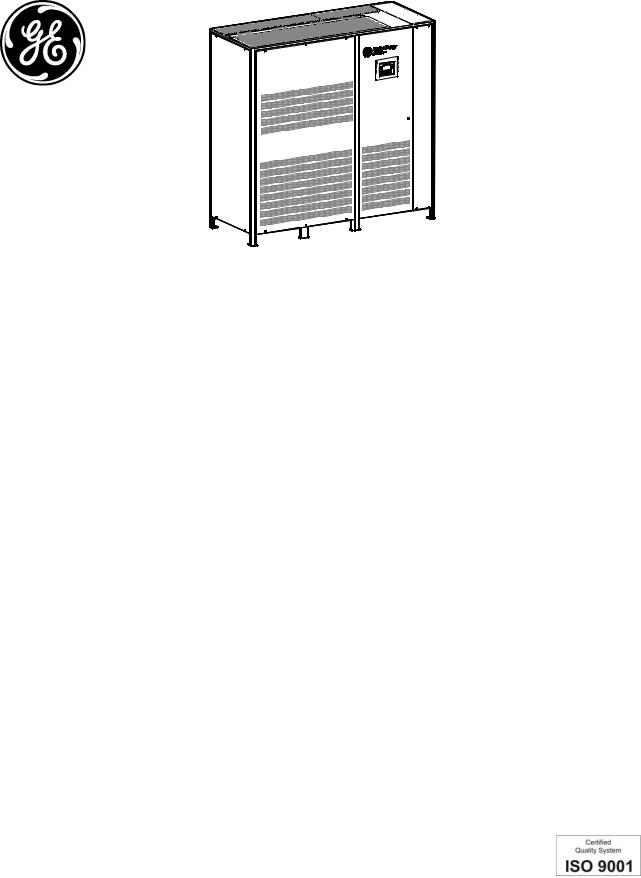
GE Digital Energy
Power Quality
|
|
_01 |
|
_UPS_GE |
|
-500_S2 |
|
|
SGS_400 |
|
|
User Manual
Uninterruptible Power supply
SG Series 400 & 500
400 & 500 kVA / 480Vac UL / S2
GE Consumer & Industrial SA
General Electric Company CH – 6595 Riazzino (Locarno) Switzerland
T +41 (0)91 / 850 51 51 F +41 (0)91 / 850 52 52
www.gepowerquality.com
imagination at work

Model: |
SG Series 400 & 500 UL S2 |
Issued by |
Product Document Department – Riazzino - CH |
Date of issue: |
06/15/2010 |
File name: |
OPM_SGT_USG_M40_M50_2US_V010 |
Revision: |
1.0 |
Identification No.: |
|
Up-dating |
|
|
Revision |
Concerns |
Date |
COPYRIGHT © 2010 by GE Consumer & Industrial SA
All rights reserved.
The information contained in this publication is intended solely for the purposes indicated.
The present publication and any other documentation supplied with the UPS system is not to be reproduced, either in part or in its entirety, without the prior written consent of GE.
The illustrations and plans describing the equipment are intended as general reference only and are not necessarily complete in every detail.
The content of this publication may be subject to modification without prior notice.

Dear Customer,
We thank you for selecting our products and are pleased to count you amongst our very valued customers at GE.
We trust that the use of the SG Series 400 & 500 Uninterruptible Power Supply system, developed and produced to the highest standards of quality, will give you complete satisfaction.
Please read carefully the User Manual, which contains all the necessary information and describes all you need to know about the use of the UPS.
Thank you for choosing GE !
START UP AND COMMISSIONING
A GE Global Services Field Engineer must perform start-up and commissioning of the UPS. Please Contact GE. Global Services at least two weeks prior to schedule start-up and commissioning at 1-800-637-1738, or by E-mail at pqservice@ge.com .
|
|
Distributed in the USA by: |
|
Your service contact: |
|
g |
|
|
g |
|
|
|
GE Digital Energy |
|
|
||
GE Consumer & Industrial SA |
|
|
Power Quality |
|
|
|
2501 Pecan Street |
|
|
||
General Electric Company |
|
|
|
||
|
Bonham, TX 75418 |
|
|
||
CH – 6595 Riazzino (Locarno) |
|
T: |
+1 800-637-1738 |
|
|
Switzerland |
|
|
|
||
|
F: |
+1 903-640-0533 |
|
|
|
www.gepowerquality.com |
|
|
|
||
|
E: GEPQSales@ge.com |
|
|
||
|
|
http://www.gedigitalenergy.com/ups |
|
|
|
|
|
|
|
|
|
Modifications reserved |
Page 3/79 |
OPM_SGS_USM_M40_M50_2US_V010.doc |
User Manual SG Series 400 & 500 UL S2 |

Preface
Congratulations on your choice of a SG Series Uninterruptible Power Supply (UPS). It will help eliminate Load disturbances due to unexpected power problems.
This Manual describes the function of the UPS module, the purpose and location of the switches, the meaning of the system events related to the front panel indication, and provides procedures for starting and stopping the equipment.
Please refer to the accompanying Installations Guide, which describes how to prepare the installation site, and it provides weight, dimensions and procedures for moving, installing and connecting the UPS.
While every care has been taken to ensure the completeness and accuracy of this manual, GE assumes no responsibility or liability for any losses or damages resulting from the use of the information contained in this document.
WARNING!
SG Series 400 & 500 is a product that needs to be installed by a licensed and knowledgeable contractor.
We recommend that this manual be kept next to the UPS for future references.
If any problems are encountered with the procedures contained in this manual, please contact your Service Center before you proceed.
This document shall not be copied or reproduced without the permission of GE.
Some of the information contained in this manual may be changed without notice to reflect technical improvements.
Safety instructions
Read the safety instructions contained on the following pages carefully before the installation of the UPS, options and battery system.
Pay attention to the rectangular boxes included in the text:
They contain important information and warning concerning electrical connections and personnel safety.
Parallel version secured with RPA
When included in the text, this symbol refers to operation needed only for parallel system.
Modifications reserved |
Page 4/79 |
OPM_SGS_USM_M40_M50_2US_V010.doc |
User Manual SG Series 400 & 500 UL S2 |
Table of contents
Page
1 |
IMPORTANT SAFETY INSTRUCTIONS ........................................................................................................... |
7 |
||
2 |
LAYOUT .......................................................................................................................................................... |
|
10 |
|
|
2.1 |
LAYOUT SG Series 400 & 500 ........................................................................................................................................................... |
10 |
|
3 |
INTRODUCTION ............................................................................................................................................ |
11 |
||
4 |
DESCRIPTION ................................................................................................................................................ |
12 |
||
|
4.1 |
BLOCK DIAGRAM AND MAIN ELEMENTS ..................................................................................................................................... |
12 |
|
|
4.2 |
OPERATION MODES.............................................................................................................................................................................. |
13 |
|
|
|
4.2.1 |
Normal operation mode........................................................................................................................................................................... |
13 |
|
|
4.2.2 eBoost™ operation mode (option) ....................................................................................................................................................... |
13 |
|
|
|
4.2.3 |
Utility failure operation ............................................................................................................................................................................. |
14 |
|
|
4.2.4 |
Utility recovery operation........................................................................................................................................................................ |
14 |
|
|
4.2.5 |
Automatic Bypass ....................................................................................................................................................................................... |
15 |
|
|
4.2.6 |
Manual Bypass (option)............................................................................................................................................................................. |
15 |
|
4.3 |
PARALLEL SYSTEM OPERATION ....................................................................................................................................................... |
16 |
|
|
|
4.3.1 Introduction to the parallel system ..................................................................................................................................................... |
16 |
|
|
|
4.3.2 Features of RPA parallel system ........................................................................................................................................................... |
17 |
|
|
|
4.3.3 |
System control.............................................................................................................................................................................................. |
17 |
|
|
4.3.4 |
Synchronization ........................................................................................................................................................................................... |
17 |
|
|
4.3.5 |
Load sharing .................................................................................................................................................................................................. |
17 |
|
4.4 |
RECTIFIERS PARALLELED ON THE SAME BATTERY.................................................................................................................. |
18 |
|
|
4.5 |
RECYCLING AT THE END OF SERVICE LIFE.................................................................................................................................. |
19 |
|
5 |
CONTROL PANEL .......................................................................................................................................... |
20 |
||
|
5.1 |
CONTROL PANEL.................................................................................................................................................................................... |
20 |
|
|
5.2 |
TABLE OF FUNCTIONS AND INDICATIONS ON CONTROL PANEL ..................................................................................... |
21 |
|
6 |
LCD SCREEN .................................................................................................................................................. |
23 |
||
|
6.1 |
HOME SCREEN ........................................................................................................................................................................................ |
23 |
|
|
6.2 |
METERING ................................................................................................................................................................................................. |
25 |
|
|
6.3 |
ALARMS...................................................................................................................................................................................................... |
28 |
|
|
|
6.3.1 Events (alarms and messages).............................................................................................................................................................. |
29 |
|
|
|
6.3.2 |
Alarms list........................................................................................................................................................................................................ |
29 |
|
|
6.3.3 |
Messages list.................................................................................................................................................................................................. |
33 |
|
|
6.3.4 Event report SG Series 400 & 500......................................................................................................................................................... |
36 |
|
|
6.4 |
SETUP 37 |
|
|
|
6.5 |
COMMANDS ............................................................................................................................................................................................. |
43 |
|
7 |
OPERATION.................................................................................................................................................... |
44 |
||
|
7.1 |
PROCEDURES FOR SINGLE SG Series 400 & 500 ..................................................................................................................... |
45 |
|
|
|
7.1.1 Start-up of the SG Series 400 & 500 .................................................................................................................................................... |
45 |
|
|
|
7.1.2 UPS shutdown with Load transfer on Manual Bypass Q2 (option)........................................................................................ |
49 |
|
|
|
7.1.3 From Manual Bypass Q2 (option) to normal function VFI.......................................................................................................... |
51 |
|
|
|
7.1.4 |
Complete UPS shutdown.......................................................................................................................................................................... |
53 |
|
|
7.1.5 Restore to normal operation after “Load Off”................................................................................................................................. |
54 |
|
|
|
7.1.6 Restore to normal operation after EPO (Emergency Power Off) ............................................................................................ |
55 |
|
Modifications reserved |
|
Page 5/79 |
||
OPM_SGS_USM_M40_M50_2US_V010.doc |
User Manual SG Series 400 & 500 UL S2 |
7.2 PROCEDURES FOR SG Series 400 & 500 PARALLEL SYSTEM AND PARALLEL SYSTEM WITH COMMON |
|
BATTERY..................................................................................................................................................................................................... |
56 |
7.2.1 SG Series 400 & 500 Parallel System start-up ................................................................................................................................ |
56 |
7.2.2 Parallel System shutdown with Load transfer on Manual Bypass Q2 (option)................................................................ |
61 |
7.2.3 From Manual Bypass Q2 (option) to normal function VFI.......................................................................................................... |
63 |
7.2.4 Separate a UPS Unit from the Parallel System (System Redundancy)................................................................................ |
65 |
7.2.5 Reconnect a UPS unit to a Parallel System...................................................................................................................................... |
67 |
7.2.6 Complete Parallel System shutdown.................................................................................................................................................. |
69 |
7.2.7 Restore to normal operation after “Load Off”................................................................................................................................. |
71 |
7.2.8 Restore to normal operation after EPO (Emergency Power Off) ............................................................................................ |
73 |
8 OPTIONS......................................................................................................................................................... |
75 |
|
8.1 |
COMMUNICATION OPTIONS ............................................................................................................................................................. |
75 |
8.2 |
OPTIONS IN UPS CABINET.................................................................................................................................................................. |
75 |
8.3 |
CONNECTION FOR OPTIONS............................................................................................................................................................. |
76 |
|
8.3.1 Remote Signaling Box (RSB) .................................................................................................................................................................... |
76 |
9 MAINTENANCE.............................................................................................................................................. |
77 |
|
9.1 MAINTENANCE........................................................................................................................................................................................ |
77 |
|
9.1.1 |
Service check................................................................................................................................................................................................. |
77 |
9.1.2 |
Fans and ventilation................................................................................................................................................................................... |
77 |
9.1.3 Other components with limited lifetime............................................................................................................................................ |
77 |
|
9.1.4 |
Battery.............................................................................................................................................................................................................. |
78 |
9.1.5 Long shut-down periods of the UPS-system .................................................................................................................................. |
78 |
|
9.1.6 UPS room conditions and temperature............................................................................................................................................. |
78 |
|
9.1.7 Long shut-down periods of the UPS-system .................................................................................................................................. |
78 |
|
10 NOTES............................................................................................................................................................. |
79 |
10.1 NOTES FORM............................................................................................................................................................................................ |
79 |
Modifications reserved |
Page 6/79 |
OPM_SGS_USM_M40_M50_2US_V010.doc |
User Manual SG Series 400 & 500 UL S2 |

1 IMPORTANT SAFETY INSTRUCTIONS
SAVE THESE INSTRUCTIONS
This manual contains important instructions for models SG Series 400 & 500 that should be followed during installation and maintenance of the UPS and battery.
GENERAL
-Move the UPS in an upright position in its original package to the final destination room. To lift the cabinets, use a forklift or lifting belts with spreader bars.
-Check for sufficient floor and elevator loading capacity.
-Check the integrity of the UPS equipment carefully.
If you notice visible damage, do not install or start the UPS. Contact the nearest Service Center immediately.
-WARNING! RISK OF ELECTRICAL SHOCK:
Do not remove covers, there are no user serviceable parts inside.
-After switching off takes 5 minutes for the DC capacitors to discharge because a lethally high voltage remains at the terminals of the electrolytic capacitors.
-All maintenance and service work should be performed by qualified service personnel. The UPS contains its own energy source (battery).
-The field-wiring outlets may be electrically live, even when the UPS is disconnected from the utility.
-Dangerous voltages may be present during battery operation.
-The battery must be disconnected during maintenance or service work.
-This UPS contains potentially hazardous voltages.
-Be aware that the inverter can restart automatically after the utility voltage is restored.
INSTALLATION
-This UPS must be installed and connected only by trained personnel.
-Verify accurately during Commissioning and Maintenance of the UPS, for the following: Damaged components, squeezed wires and cables, or not correctly inserted plugs.
-After removing the sidewalls of the UPS, make sure that all earth connections when reassembling, are correctly reattached.
-This UPS is intended for use in a controlled indoor environment free of conductive contaminants and protected against animals intrusion.
-WARNING! HIGH EARTH LEAKAGE CURRENT:
Earth connection is essential before connecting to AC input!
-Switching OFF the unit does not isolate the UPS from the utility.
-Do not install the UPS in an excessively humid environment or near water.
-Avoid spilling liquids on or dropping any foreign object into the UPS.
-The unit must be placed in a sufficiently ventilated area; the ambient temperature should not exceed 104°F (40°C).
-Optimal battery life is obtained if the ambient temperature does not exceed 77°F (25°C).
-It is important that air can move freely around and through the unit. Do not block the air vents.
-Avoid locations in direct sunlight or near heat sources.
STORAGE
-Store the UPS in a dry location; storage temperature must be within -13°F (-25°C) to 131°F (+55°C).
-The optimal temperature for Battery storage is 68°F (20°C) to 77°F (25°C) and shall never exceed the range - 4°F (-20°C) to 104°F (40°C).
-If the unit is stored for a period exceeding 3 months, the battery must be recharged periodically (time depending on storage temperature).
BATTERY
-The battery-voltage is dangerous for person’s safety.
-When replacing the battery, use the same cells number, voltage (V), capacity (Ah). All the battery used, shall be of the same manufacturer and date of production.
-Proper disposal or recycling of the battery is required. Refer to your local codes for disposal requirements.
-Never dispose of battery in a fire: they may explode.
-Do not open or mutilate battery: their contents (electrolyte) may be extremely toxic. If exposed to electrolyte, wash immediately with plenty of water.
-Avoid charging in a sealed container.
-Never short-circuit the batteries.
When working with batteries, remove watches, rings or other metal objects, and only use insulated tools.
-In case of air shipment, the cables +/- going to the battery fuses/terminals shall be disconnected and isolated.
Modifications reserved |
Page 7/79 |
OPM_SGS_USM_M40_M50_2US_V010.doc |
User Manual SG Series 400 & 500 UL S2 |

Safety instructions when working with battery
EXTERNAL BATTERY MUST BE INSTALLED AND CONNECTED TO THE UPS BY QUALIFIED SERVICE PERSONNEL ONLY.
INSTALLATION PERSONNEL MUST READ THIS ENTIRE SECTION BEFORE HANDLING THE UPS AND BATTERY.
DANGER!
Full voltage and current are always present at the battery terminals.
The battery used in this system can provide dangerous voltages, extremely high currents and a risk of electric shock.
If the terminals are shorted together or to ground they may cause severe injury.
You must be extremely careful to avoid electric shock and burns caused by contacting battery terminals or shorting terminals during battery installation.
Do not touch uninsulated battery terminals.
A qualified service person, who is familiar with battery systems and required precautions, must install and service the battery.
The installation must conform to national and local codes. Keep unauthorized personnel away from the battery.
The qualified service person must take these precautions:
1Wear protective clothing, such as rubber gloves and boots and protective eye wear Batteries contain caustic acids and toxic materials and can rupture or leak if mistreated. Remove rings and metal wristwatches or other metal objects and jewelry.
Do not carry metal objects in your pockets where the objects can fall into the battery cabinet.
2Tools must have insulated handles and must be insulated so that they will not short battery terminals.
Do not allow a tool to short between individual or separate battery terminals or to the cabinet or rack.
Do not lay tools or metal parts on top of the battery, and do not lay them where they could fall onto the battery or into the cabinet.
3Install the battery as shown on the drawing provided with the battery.
When connecting cables, never allow a cable to short across a battery’s terminals, the string of battery, or to the cabinet or rack.
4Align the cables on the battery terminals so that the cable lug will not contact any part of the cabinet or rack, even if the battery is moved.
Keep the cable away from any sharp metal edges.
5Install the battery cables in such a way that the UPS or battery cabinet doors cannot pinch them.
6Do not connect the battery terminal to Ground.
If any battery terminal is inadvertently grounded, remove the source of the ground. Contacting any part of a grounded battery can cause a risk of electric shock.
7To reduce the risk of fire or electric shock, install the battery in a temperature and humidity controlled indoor area, free of contaminants.
8Battery system chassis ground (earth) must be connected to the UPS chassis ground (earth). If you use conduits, this ground conductor must be routed in the same conduit as the battery conductors.
9Where conductors may be exposed to physical damage, protect the conductors in accordance with all applicable codes.
10If you are replacing the battery or repairing battery connections, shut OFF the UPS and remove the battery fuses.
Modifications reserved |
Page 8/79 |
OPM_SGS_USM_M40_M50_2US_V010.doc |
User Manual SG Series 400 & 500 UL S2 |
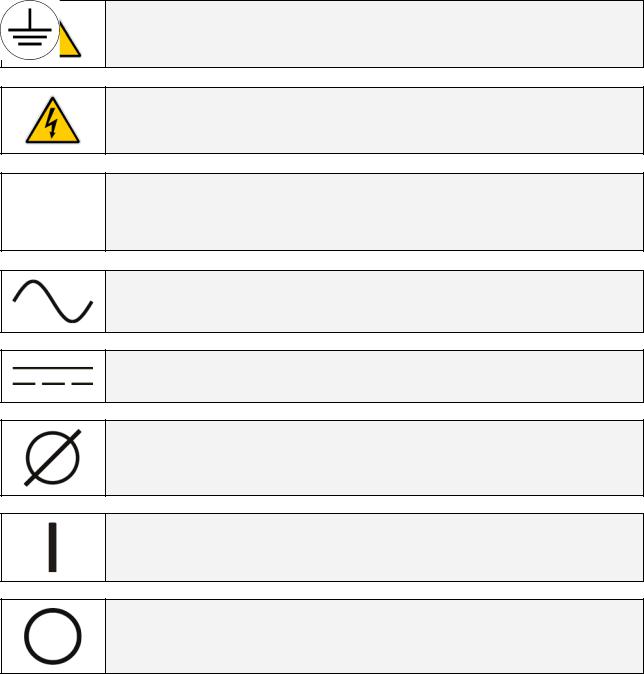
Safety symbols and warnings
Safety warnings
The text of this manual contains some warnings to avoid risk to the persons and to avoid damages to the UPS system and the supplied critical loads.
The non-observance of the warnings reminding hazardous situations could result in human injury and equipment damages.
Please pay attention to the meaning of the following warnings and symbols.
Throughout this manual the following symbols are defined:
WARNING, if instruction is not followed injury or serious equipment damage may occur!
CAUTION, internal parts have dangerous voltage present.
Risk of electric shock!
PE (Earth) – GND (Ground) PROTECTIVE GROUNDING TERMINAL:
A terminal which must be connected to earth ground prior to making any other connection to the equipment.
A terminal to which or from which an alternating (sine wave) current or voltage may be applied or supplied.
A terminal to which or from which a direct current or voltage may be applied or supplied.
This symbol indicated the word “phase”.
This symbol indicates the principal on/off switch in the on position.
This symbol indicates the principal on/off switch in the off position.
Modifications reserved |
Page 9/79 |
OPM_SGS_USM_M40_M50_2US_V010.doc |
User Manual SG Series 400 & 500 UL S2 |
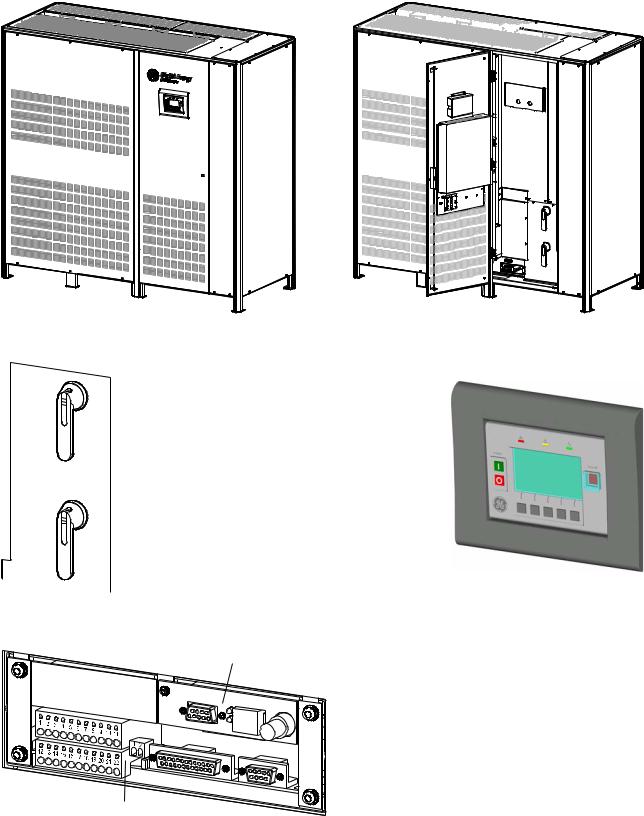
2 LAYOUT
2.1LAYOUT SG Series 400 & 500
SGS_ |
|
|
400-500_ |
|
|
|
S2_UPS_ |
|
|
|
GE_02 |








 SGSU_400-500_S2_UPS_03
SGSU_400-500_S2_UPS_03
Q1 |
0 OFF |
I |
|
|
ON |
Q2 |
0 OFF |
I |
|
|
ON |
Fig. 2.1-1 SG Series 400 & 500 general view
Q1 |
0 OFF |
I |
|
|
ON |
-Q2 01 |
Q2 |
0 |
OFF |
|
Q1 |
|
|
||
|
|
|
||
S2 Switches |
|
|
ON I |
|
SGS 400-500_ |
|
|
|
|
Fig. 2.1-3 Manual operated switches |
|
|||
SG |
|
|
|
SNMP |
S_ |
400-500_ |
mer interface_03 |
||
|
||||
|
|
Custo |
|
|
P4
Fig. 2.1-5 Connectivity Rack
Modifications reserved
Fig. 2.1-2 SG Series 400 & 500 general view with open doors
|
Fig. 2.1-4 Control panel |
|
P4 |
Customer Interface Board |
|
Q1 |
UPS output switch |
|
Q2 |
Manual Bypass switch (option) |
|
SNMP |
3-ph SNMP/WEB plug-in adapter (option) |
|
XA |
Terminals for 24Vdc |
|
Auxiliary Power Supply connection |
||
|
||
XB |
Terminals for EPO (Emergency Power |
|
Off) connection |
||
|
||
|
Page 10/79 |
OPM_SGS_USM_M40_M50_2US_V010.doc |
User Manual SG Series 400 & 500 UL S2 |
3 INTRODUCTION
An Uninterruptible Power Supply (UPS) provides the power for critical loads that need a reliable, continuous, disturbance free supply.
In case the power provided by the Utility fails, or exceeds the permitted tolerances, the power to supply the Load is provided by the Battery for the specified time at the rated Load (or longer at a reduced Load) or until the Utility power returns.
SG Series 400 & 500 is a true double conversion VFI (Voltage Frequency Independent) UPS system where the Load is continuously supplied by the Inverter through the Rectifier.
In case of trouble on the Inverter Output Voltage, or when overload or short-circuit on the output occur, the Load is instantly transferred to the Utility via the Automatic Bypass.
The UPS automatically returns to normal mode when the failure condition is restored.
Key features:
•More Critical equipment supported
Rated at 0.9 Power Factor, SG Series 400 & 500 delivers more real power than other UPS in the market.
With today’s trend toward power factor corrected loads, SG Series 400 & 500 can support more total Load than any other UPS available, allowing you to support a greater number of today’s enterprise computing Power Factor Corrected (PFC) equipment.
•No single point of failure
Redundant Parallel Architecture (RPA) is an exclusive GE technology.
With RPA, SG Series 400 & 500 UPS are controlled in a true peer-to-peer configuration where all critical elements and functions (including Bypass) are redundant.
SG Series 400 & 500 is designed to be the most reliable power protection system available on the market today.
•High Efficiency
Using IGBT technology and Space Vector Modulation (SVM) strategy, SG Series 400 & 500 offers low output voltage distortion and provides efficiencies up to 93%.
•Fully digital
Digital Signal Processor (DSP), Flash memory and SVM strategy, are the technology corner stones of new age of power quality and power reliability.
•Extremely flexible
Tailor made power protection to meet your individual installation requirements; SG Series 400 & 500 offers various options like input harmonic filters and our comprehensive GE Power Diagnostic software suite for mission control and data protection to cover all your application needs.
Modifications reserved |
Page 11/79 |
OPM_SGS_USM_M40_M50_2US_V010.doc |
User Manual SG Series 400 & 500 UL S2 |
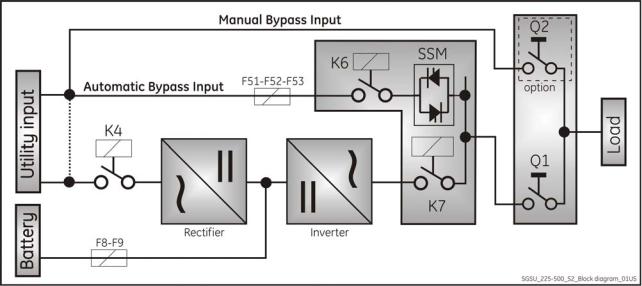
4 DESCRIPTION
4.1BLOCK DIAGRAM AND MAIN ELEMENTS
Fig. 4.1-1 Block diagram
The SG Series 400 & 500 system can be divided into the following main elements:
Control System
SG Series 400 & 500 is designed with microprocessor-controlled signal processing circuits.
The interface between the operator and the unit is provided by the monitoring system on the front panel. This monitoring system consists of an active mimic diagram, a keyboard and a backlit display.
Rectifier
The standard Rectifier consists of a 6-pulse SCR-bridge, which converts the 3-phase Utility Voltage into a controlled and regulated DC-voltage.
This regulated DC-voltage is used to supply power to the Inverter, and to provide charging power to the
Battery.
Inverter
The Inverter converts the DC voltage into a three-phase AC-voltage with constant amplitude and frequency, which is completely independent and isolated from the AC-input voltage.
Automatic Bypass
The Automatic Bypass consists of a static semiconductor-switch (SSM: Static Switch Module), used to provide an uninterrupted transfer of the Load from Inverter to Utility.
Back-feed Protection
All SG Series UPS's are equipped with an automatic system for the protection against voltage back feeding towards Utility, through the Bypass (Applied Standard IEC 62040-1).
This protection works automatically by opening contactor K6 and eventually K7, and acts in case of internal defects of the system, or due to wrong manipulations on the Manual Bypass Q2 (option).
Manual Bypass (option)
The Manual Bypass consists of a pair of manual switches (Q1 and Q2), which removes the UPS from the Load for maintenance, while still supplying the Load with power directly from the Utility.
Battery
The Battery supplies the DC power to the Inverter when the Utility is out of accepted tolerances.
Modifications reserved |
Page 12/79 |
OPM_SGS_USM_M40_M50_2US_V010.doc |
User Manual SG Series 400 & 500 UL S2 |
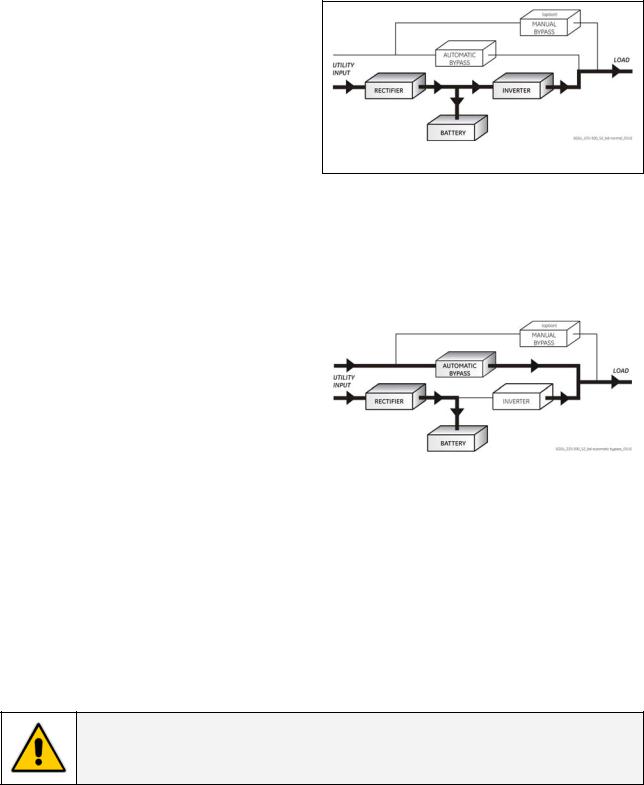
4.2OPERATION MODES
4.2.1 Normal operation mode |
|
|
During normal operation, the Rectifier converts |
|
|
input AC power to DC. |
|
|
The DC power provides input power for the |
|
|
Inverter and charging power for the Battery. |
|
|
The Inverter converts the DC power to continuous |
|
|
and regulated AC power, which supplies the |
|
|
critical load. |
|
|
The control panel reports the Battery charge |
|
|
status and the expected backup time with the |
Fig. 4.2.1-1 Block diagram normal operation mode |
|
actual load. |
||
|
4.2.2 eBoost™ operation mode (option)
eBoost™ |
|
|
e |
high efficiency (up to 99%) |
|
Boost |
fast power transfer (< 4ms) |
|
When the eBoost™ Operation Mode is selected, |
|
|
and the Utility Power is available, the Load is |
|
|
normally powered through the Automatic |
|
|
Bypass. |
|
|
When the Utility Voltage is detected out of the |
Fig. 4.2.2-1 Energy flow in eBoost™ Operation Mode |
|
prescribed tolerances, the Load is automatically |
||
transferred to the Inverter. |
|
|
When the Utility recovers, the Load returns to the Automatic Bypass after a variable time defined by the control unit.
The eBoost™ Operation Mode can be configured directly by the user for scheduled activation, considering the Utility reliability and criticality of the Load.
The selection between the two operation modes “VFI Mode and eBoost™ Operation Mode”, or switching between operation modes at required time, can be done through the UPS control panel (see Section 7.4 / eBoost).
NOTE !
The eBoost™ Operation Mode is available only if enabled at the factory or by a GE GLOBAL SERVICES FIELD ENGINEER.
Modifications reserved |
Page 13/79 |
OPM_SGS_USM_M40_M50_2US_V010.doc |
User Manual SG Series 400 & 500 UL S2 |
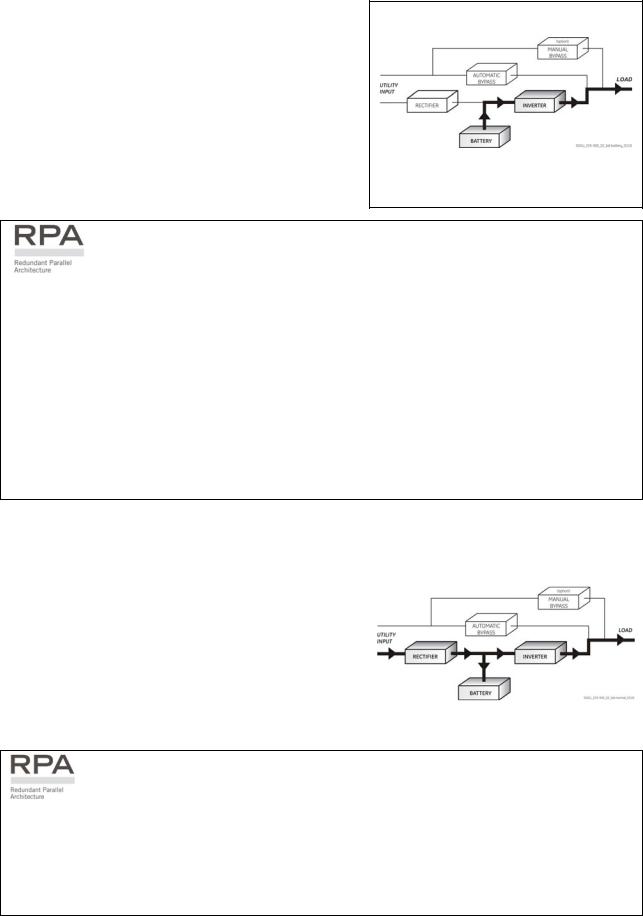
4.2.3 Utility failure operation |
|
When the Utility is no longer within acceptable |
|
tolerances, the Battery will provide the DC power to the |
|
Inverter. |
|
The Inverter will maintain continuous AC power to the |
|
Load until the Battery Voltage reaches the lower limit of |
|
the Inverter operation capability. |
|
During the discharge, the LCD screen displays the |
|
estimated time the Battery can support the critical Load. |
|
Prior to the Battery completely discharging, the "stop |
|
operation" alarm (shutdown imminent) warns the |
Fig. 4.2.3-1 Block diagram Utility Failure operation |
operator that the Battery is almost discharged and the |
|
UPS is about to shut down. |
|
In case of parallel operation
With a parallel system for power capacity (see Section 4.3)
•With the Bypass Utility power available, a low Battery warning on any unit will cause the Load to be transferred to Utility (after a selectable time delay).
•With Bypass Utility power not available, a low Battery warning on any unit will start the “stop operation” timer (adjustable). The Load will shut down at the end of the “stop operation” time period.
With a parallel system for redundancy (see Section 4.3)
•When a Battery low warning occurs on a unit not necessary to support the present load, this unit will shut down after a timeout period (selectable). The Load is shared between the other units.
As the warning occurs on one unit necessary to support the present load, the system starts the "stop operation" timeout (selectable).
The Load will shut down at the end of the “stop operation” time period.
4.2.4 |
Utility recovery operation |
|
As soon as the AC input power recovers, the Rectifier will |
|
|
|
||
start automatically, supplying DC power to the Inverter |
|
|
and recharging the Battery. |
|
|
If the Inverter was previously shut down due to low |
|
|
Battery, the Load will be initially powered by Utility |
|
|
through the Automatic Bypass. |
|
|
When the Battery is recharged enough to ensure a |
|
|
minimum time of operation with the present load, the |
|
|
Inverter |
will start automatically and the Load will be |
Fig. 4.2.4-1 Block diagram Utility recovery operation |
transferred back to the Inverter. |
|
|
In case of parallel operation
When the AC input power recovers, the Rectifiers will start up sequentially, according to their number in the parallel system. This minimizes the initial inrush current.
The Inverters will start up automatically, but only when the Battery has recharged enough for a minimum runtime with the present load.
When enough Inverters to supply the Load have been restarted, the Load will be transferred from the Automatic Bypass back to the Inverter output.
Modifications reserved |
Page 14/79 |
OPM_SGS_USM_M40_M50_2US_V010.doc |
User Manual SG Series 400 & 500 UL S2 |
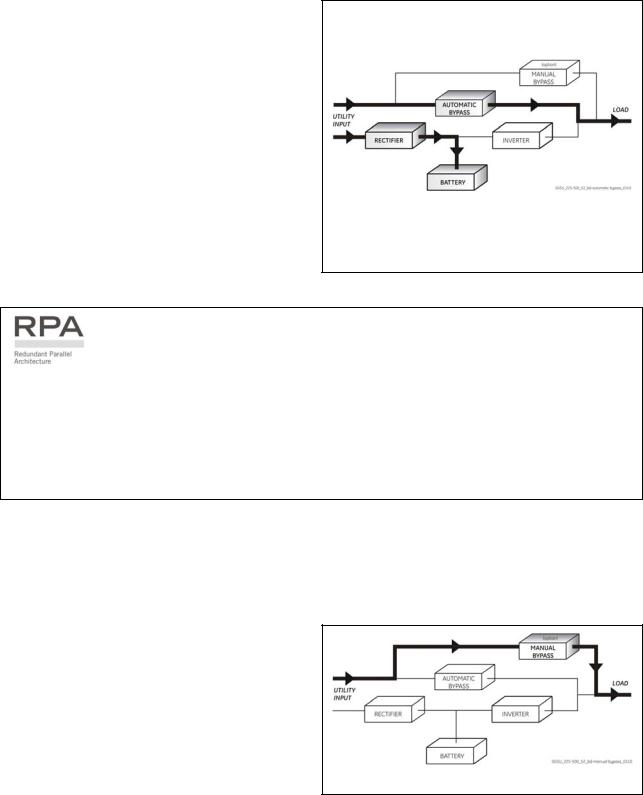
4.2.5 Automatic Bypass |
|
In normal operation, the Load is supplied by the |
|
Inverter. |
|
When the control system detects a fault in the |
|
Inverter, an overload condition or a short-circuit |
|
condition, the Automatic Bypass will transfer the |
|
critical Load to the Utility without interruption. |
|
When the Inverter recovers, or the overload or |
|
short-circuit condition is corrected, the Load will |
|
be automatically transferred back to the Inverter. |
|
If the UPS is unable to return to normal mode |
|
following an automatic transfer to Bypass mode, |
Fig. 4.2.5-1 Block diagram Automatic Bypass |
an alarm condition will be initiated. |
|
A Manual Bypass (operator initiated) will not be |
|
considered as an alarm condition. |
|
In case of parallel operation
Each unit has its own internal Bypass.
These units are continuously exchanging information, enabling all of the internal Bypass circuits in a parallel system to operate simultaneously.
If the Inverter of a unit fails, its Bypass circuit remains available to the Parallel System.
It is excluded only if the unit is separated from the common bus by opening its output switch Q1.
4.2.6 Manual Bypass (option)
The Manual Bypass circuit consists of Q1 and Q2 manual switches, which permits transfer of the Load directly to the unconditioned AC power without interruption, leaving the UPS available for maintenance.
Fig. 4.2.6-1 Block diagram Manual Bypass
Modifications reserved |
Page 15/79 |
OPM_SGS_USM_M40_M50_2US_V010.doc |
User Manual SG Series 400 & 500 UL S2 |
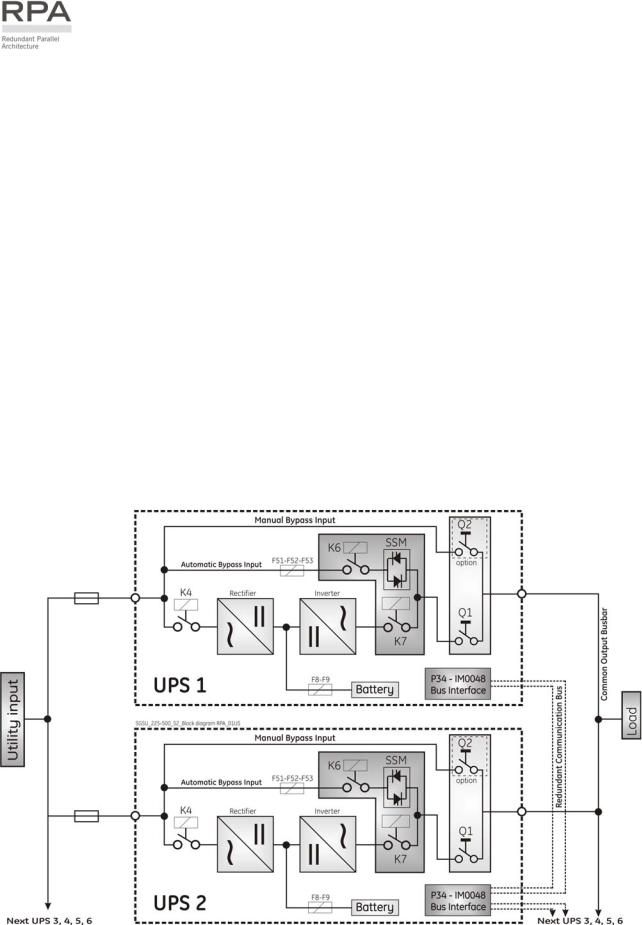
4.3PARALLEL SYSTEM OPERATION
4.3.1 Introduction to the parallel system
Two or more equal power units can be paralleled to increase the output power (paralleling for capacity) or to improve the overall reliability of an UPS system (paralleling for redundancy).
The outputs of parallel units are connected to a common power bus, and in normal operation the units connected on the parallel bus share the Load equally.
The modular concept of SG Series 400 & 500 allows parallel operation of up to 6 units, without using paralleling switchgear, external bypass circuits or common control circuitry (see Fig. 4.3.1-1).
Parallel units for power capacity
Several units can be paralleled in order to achieve output power greater than the maximum power of a single unit.
The maximum total power shared between the paralleled units is equal to the total installed nominal power.
In the event of a failure of one unit, the power supplied by the UPS system becomes insufficient and the Load will be transferred to the Utility Bypass source.
Parallel units for redundancy
The nominal power rating of the n+1 out of n redundant paralleled modules must be equal to or greater than the required Load power.
The Load will be equally shared by the n units connected on the output bus.
Should one of the n paralleled units trip Off-line, the remaining (n+1) modules will supply the load, maintaining conditioned power to the critical load.
From this results higher reliability and security for the Load plus a higher MTBF (Mean Time Between Failures).
|
Fig. 4.3.1-1 Block diagram parallel system operation |
Modifications reserved |
Page 16/79 |
OPM_SGS_USM_M40_M50_2US_V010.doc |
User Manual SG Series 400 & 500 UL S2 |

4.3.2 Features of RPA parallel system
The SG Series 400 & 500 Parallel System is designed to provide a complete Redundant Parallel Architecture, and is free from common equipment.
Not only the Inverters are redundant, but also the Bypass functions are designed with redundant modular concept.
When one UPS needs maintenance or service, the Load is powered by the other units supplying the
Load bus.
The redundant communication bus to which all units are connected keeps each unit informed about the status of all the other units.
The control panel located on each unit allows controlling and monitoring the status of this unit.
4.3.3 System control
A high-speed redundant, serial communication bus guarantees the exchange of data and thus the communication between the CPU's of each unit.
Each module controls it's own function and operational status and communicates with all other modules, in order to act or react if necessary, adapting it to the new conditions.
4.3.4 Synchronization
All units are identical, but one unit is arbitrarily selected as the reference and all the other units synchronize to this unit, which in turn, synchronizes to the Utility Bypass voltage, as long as the later is within tolerances.
In case of reference failure, another unit in the parallel system is automatically chosen to take over the reference role.
The Bypass Input for all the units of the parallel system must be supplied from the same AC source (no phase shift allowed between them).
4.3.5 Load sharing
On each unit of the parallel system, Inverter Output Voltage and Current are measured and applied to a Load sharing bus.
An eventual difference between the units is therefore automatically equalized.
NOTE !
It is strongly recommended that no transformers, automatic circuit breakers or fuses should be inserted between the unit’s output and the Load common bus bars.
However, it is recommended that a disconnect or isolation switch be inserted.
Modifications reserved |
Page 17/79 |
OPM_SGS_USM_M40_M50_2US_V010.doc |
User Manual SG Series 400 & 500 UL S2 |
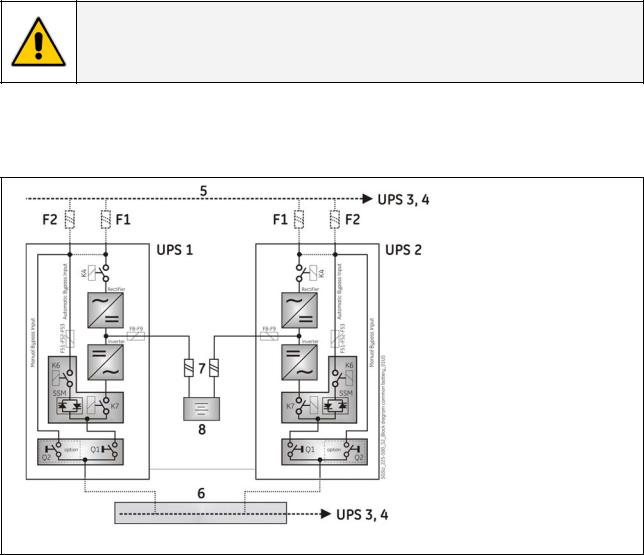
4.4RECTIFIERS PARALLELED ON THE SAME BATTERY
NOTE !
A parallel system with a Common Battery for two or more Rectifiers, requires a particular installation and adequate setting of some parameters, (accessible only through password), and can therefore only be done by a qualified engineer from GE.
Usually each Rectifier-Inverter Unit runs with its own Battery.
In case of parallel units are running with a Common Battery (max. 4 UPS - see Fig 4.4-1), the sharing circuit between individual Rectifier is integrated in the communication bus of the system in order to assure an equal sharing of the Rectifiers output currents.
1 – Rectifier
2 – Inverter
3 – Automatic Bypass
4 – Manual Bypass
5 – Utility Power
6 – Load Bus Bar
7 – External Battery Fuse
8 – Battery
Fig. 4.4-1 Diagram RPA system with Rectifiers on Common Battery
Pay attention to the following recommendations:
•The units delivered for this functioning mode needs a special parameters setting, so they must be prepared in advance before the installation.
•The installation must be performed only with the UPS system must be completely shut down.
•The AC Rectifiers input power (5) must be the same, with clockwise phase rotation for each unit.
•Each Rectifier must be set for the same floating DC voltage and the same Battery current limitation.
•It is mandatory to install the fuses / MCCB (7) on each line connecting the Rectifiers to the common Battery for maintenance / safety reasons.
•In case one must be powered down for maintenance, switch-OFF the concerned unit before open the DC fuses / MCCB on the Battery line (7).
•It is mandatory to connect an external NO free contact “Battery Fuses” to the UPS and to enable the function by setting the parameter (see Section 4.1 of the “Installation Guide”).
•If an emergency generator set supply the UPS, and the free contact “Generator ON” is connected to the Customer interface, connect a separate NO free contact on each parallel unit.
•The parameters enabling the Battery test, both manual and automatic, must be set in the same mode on all the units having the Rectifiers on Common Battery.
•Do not connect the temperature sensor for automatic battery floating voltage compensation.
•Do not enable the function Boost charge (parameter 87).
Modifications reserved |
Page 18/79 |
OPM_SGS_USM_M40_M50_2US_V010.doc |
User Manual SG Series 400 & 500 UL S2 |
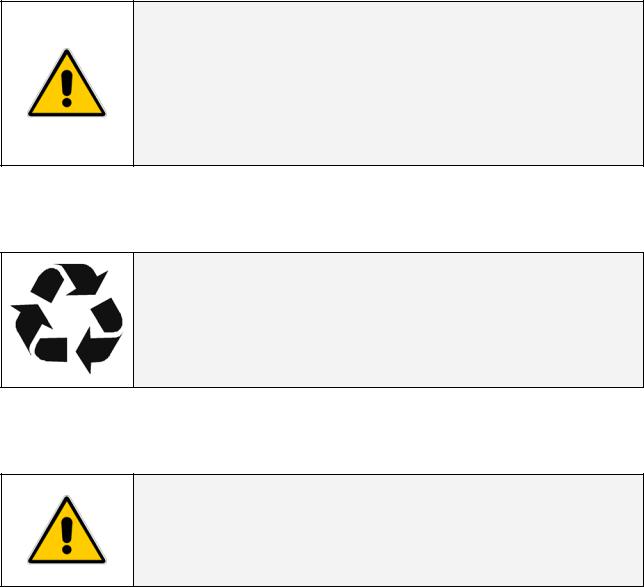
4.5RECYCLING AT THE END OF SERVICE LIFE
NOTE !
This product has been designed to respect the environment, using materials and components respecting eco-design rules.
It does not contain CFCs (chlorofluorocarbons) or HCFCs (hydrochlorofluorocarbons).
RECYCLING AT THE END OF SERVICE LIFE !
GE, in compliance with environment protection recommends to the User that the UPS equipment, at the end of its service life, must be recovered conforming to the local applicable regulations.
WARNING !
Leads contained in the batteries is a dangerous substance for the environment, therefore it must be correctly recycled by specialized companies!
Modifications reserved |
Page 19/79 |
OPM_SGS_USM_M40_M50_2US_V010.doc |
User Manual SG Series 400 & 500 UL S2 |
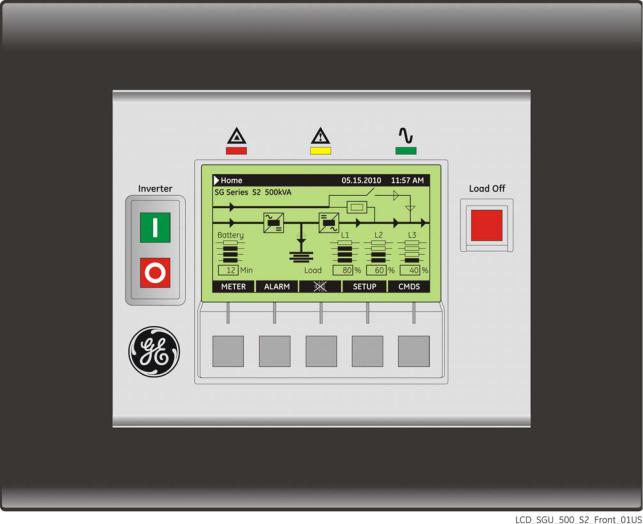
5 CONTROL PANEL
5.1CONTROL PANEL
Fig. 5.1-1 Control panel
The control panel, positioned on the UPS front door, acts as the UPS user interface and comprises of the following elements:
•Back lit Graphic Display (LCD) with the following characteristics:
−Multilanguage communication interface:
English, German, Italian, Spanish, French, Finnish, Polish, Portuguese, Czech, Slovakian, Chinese, Swedish, Russian and Dutch;
−Synoptic Diagram indicating UPS status.
•Command pushbuttons and parameters setting.
•UPS status control LED.
Modifications reserved |
Page 20/79 |
OPM_SGS_USM_M40_M50_2US_V010.doc |
User Manual SG Series 400 & 500 UL S2 |
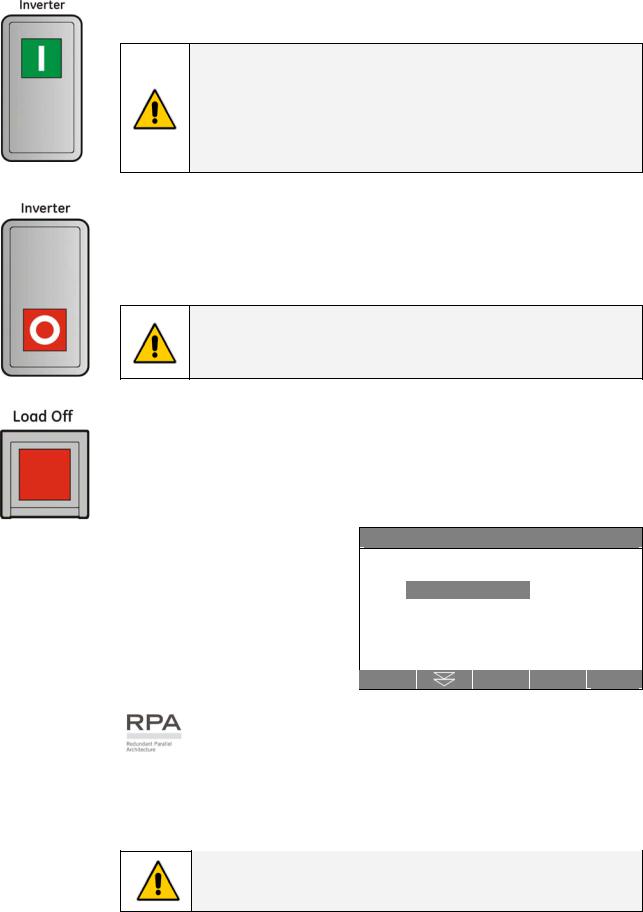
5.2TABLE OF FUNCTIONS AND INDICATIONS ON CONTROL PANEL
Key to switch the Inverter ON ( I )
NOTE !
When eBoost™ Operation Mode is enabled, control of Inverter status and selection of the feed path is done autonomously by the UPS control logic.
Therefore, Inverter ON / Inverter OFF commands are disabled when eBoost™ Operation Mode is enabled.
Key for Inverter shutdown ( O )
Press the key to transfers the Load to Utility.
Keep pressed for 5 seconds to shutdown the Inverter.
This key is also used as the EPO (Emergency Power Off) reset.
NOTE !
Inverter OFF command is disabled when eBoost™ Operation Mode is enabled.
Key “Load Off”
The key “Load Off” is protected by a transparent cover.
By pressing it, you immediately separate the UPS from the Load.
It is possible to activate the command “Load Off” using the following links:
COMMANDS / TOTAL OFF REQUEST. See Section 6.5.
To reset “Load Off”
Restore the command “Load Off” by entering the screen:
COMMANDS / RESET TOTAL OFF
`Home\Commands
COMMANDS
RESET TOTAL OFF
REQUEST TOTAL OFF
V |
|
For Parallel System:
If “Load Off” is pressed on one unit connected to the parallel bus (switch Q1 closed), all the units are separated from the load.
The “Load Off” reset must be done only on one unit connected to the parallel bus (switch Q1 closed).
NOTE !
Special care must be taken in using this command, in order to avoid accidental load disconnection.
Modifications reserved |
Page 21/79 |
OPM_SGS_USM_M40_M50_2US_V010.doc |
User Manual SG Series 400 & 500 UL S2 |
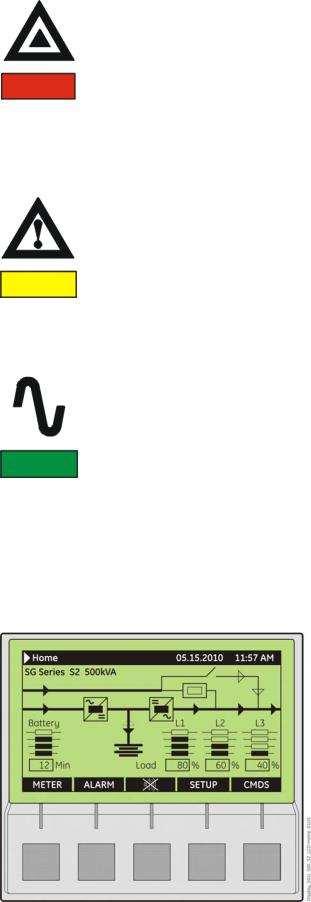
LED Stop Operation (red color)
It warns about the imminent inverter stop (default parameter = 3 min.) and the consequent load shutdown as result of:
•The battery is fully discharged and the load cannot be transferred on utility.
•Overtemperature or overload condition (>125%) and the load cannot be transferred on utility.
LED Alarm (yellow color)
It blinks when one or more alarm is activated. The internal buzzer is ON.
The LED remains lighted (with the alarm condition still present) and the buzzer stops when the key “MUTE” is pressed.
The LED is also lit when the load is not protected by UPS or in case Q1 is open.
LED Operation (green color)
When lit, indicates that the UPS is functioning correctly and the load is system protected (Load supplied from inverter).
When blinking, indicates that a regular maintenance service is needed (SERVICE REQUIRED).
May be reset by a service technician only. See Section 9 – Maintenance – Service check.
The LED is OFF when the output switch Q1 is open, indicating that the Inverter is in service mode, not supplying the load.
User LCD Interface
The user interface consists of a Back lit Graphic Display (LCD) having:
• Synoptic Diagram indicating UPS status.
• UPS operating, AC and DC metering information.
• History of events (alarms and messages).
• Functionality can be programmed to meet customer needs by changing parameters.
• Operation commands of the UPS.
Modifications reserved |
Page 22/79 |
OPM_SGS_USM_M40_M50_2US_V010.doc |
User Manual SG Series 400 & 500 UL S2 |
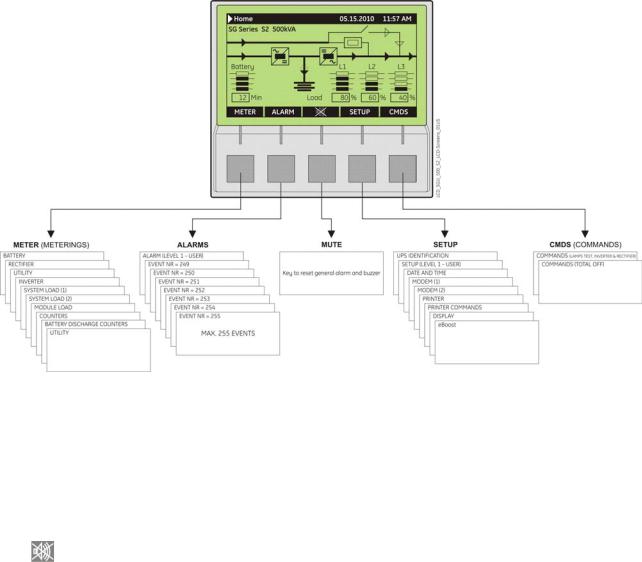
6 LCD SCREEN
6.1HOME SCREEN
|
|
Fig. 6.1-1 LCD display |
The buttons perform the following functions: |
||
|
METERING |
View electric parameters values and statistics of use. |
METER |
||
|
|
See Section 6.2. |
|
|
|
|
ALARMS |
Shows in chronological order, all the events occurred (alarms, |
ALARM |
||
|
|
messages, commands, handling, etc.). See Section 6.3. |
|
|
|
|
MUTE |
Key to reset general alarm and buzzer. |
|
||
|
SETUP |
Allows the user to customize some UPS functions to specific |
SETUP |
||
|
|
requirements and to view UPS identification data. See Section 6.4. |
|
|
|
|
COMMANDS |
Allows the user to execute UPS operation commands. |
CMDS |
||
|
|
See Section 6.5. |
|
|
|
The LCD screen, after 5 minutes of inactivity, shuts down the backlight. To reactivate it, it is sufficient to press any pushbuttons.
If the keypad remains inactive for 5 minutes or longer, during the viewing of a screen such as MEASURES, ALARMS, SETUP or COMMANDS, the LCD screen returns automatically to the main screen.
It is possible to view any pushbutton functional description by pushing the button for more than 3 seconds.
Pushing the pushbuttons “METER” (1st button) and “ALARM” (2nd button) together automatically sets the LCD communication for “ENGLISH”.
Modifications reserved |
Page 23/79 |
OPM_SGS_USM_M40_M50_2US_V010.doc |
User Manual SG Series 400 & 500 UL S2 |
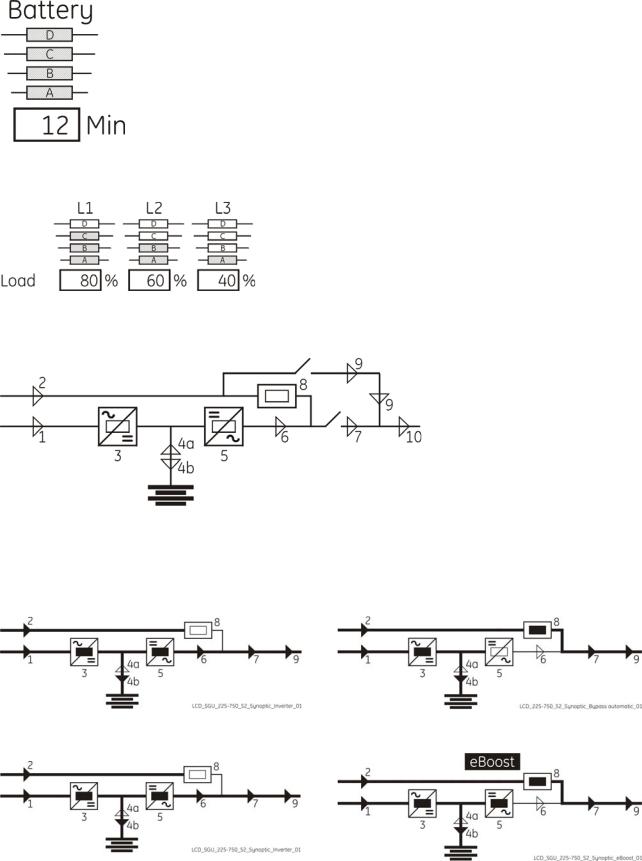
SG Series S2 500 |
UPS Model |
UPS series number |
UPS nominal rating (kVA) |
Battery level LED
All lightning lit LED open indicate a battery autonomy of 100%.
LED A |
Fixed: |
indicates a battery autonomy between 6% and 25%. |
|
Blinking: |
indicates a battery autonomy ≤5%. |
LED A, B |
Indicate a battery autonomy between 26% and 50%. |
|
LED A, B, C |
Indicate a battery autonomy between 51% and 99%. |
|
Min: |
Battery autonomy time in minutes estimates with actual load. |
|
Load level LED
All LED Off indicate a load status at ≤25%.
LED A |
Indicates a load level between 26% and 50%. |
LED A, B |
Indicate a load level between 51% and 75%. |
LED A, B, C |
Indicate a load level between 76% and 100%. |
LED A, B, C, D |
Indicate a load level between 101% and 124%. |
LED D blinking |
Indicates a load level ≥125%. |
Fig. 6.1-2 LEDs on Synoptic Diagram
Examples of typical scenarios in the Synoptic Diagram:
LEDs on Synoptic Diagram
LED 1 Utility Rectifier OK LED 2 Utility Bypass OK LED 3 Rectifier ON
LED 4a Discharging Battery LED 4b Charging Battery LED 5 Inverter available LED 6 Inverter ON
LED 7 Q1 closed (load on UPS) LED 8 Automatic Bypass ON LED 9 Manual Bypass Q2 ON LED 10 Load on UPS
Load supplied by Inverter |
Load supplied by Automatic Bypass |
Load supplied by Battery |
Load supplied by eBoost™ Operation Mode (option) |
When the Load is supplied by eBoost™ Operation Mode the “eBoost” text is displayed.
Modifications reserved |
Page 24/79 |
OPM_SGS_USM_M40_M50_2US_V010.doc |
User Manual SG Series 400 & 500 UL S2 |
